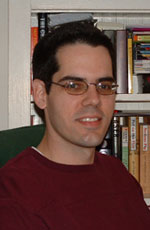Dr. Charles R. Keeton II
The New Scientist article Satellite could open door on extra dimension said
An exotic theory, which attempts to unify the laws of physics by proposing the existence of an extra fourth spatial dimension, could be tested using a satellite to be launched in 2007.
Such theories are notoriously difficult to test. But a new study suggests that such hidden dimensions could give rise to thousands of mini-black holes within our own solar system — and the theory could be tested within Pluto’s orbit in just a few years…
Now, Keeton and colleague Arlie Petters at Duke University in North Carolina, US, have calculated how many of these tiny black holes should exist — and how they might be detected – according to an offshoot of string theory.
The theory they use, called the Randall-Sundrum braneworld model, proposes that the 3D universe we live in is floating within a larger universe with an extra spatial dimension.
The PhysOrg.com article Scientists Predict How to Detect a Fourth Dimension of Space said
Scientists at Duke and Rutgers universities have developed a mathematical framework they say will enable astronomers to test a new five-dimensional theory of gravity that competes with Einstein’s General Theory of Relativity.
Charles R. Keeton of Rutgers and Arlie O. Petters of Duke base their work on a recent theory called the type II Randall-Sundrum braneworld gravity model. The theory holds that the visible universe is a membrane (hence “braneworld”) embedded within a larger universe, much like a strand of filmy seaweed floating in the ocean. The “braneworld universe” has five dimensions — four spatial dimensions plus time — compared with the four dimensions — three spatial, plus time — laid out in the General Theory of Relativity.
The framework Keeton and Petters developed predicts certain cosmological effects that, if observed, should help scientists validate the braneworld theory. The observations, they said, should be possible with satellites scheduled to launch in the next few years.
Dr. Charles R. Keeton II is
Assistant Professor of
Department of Physics and Astronomy at
Rutgers University.
He was previously a
NASA Hubble Fellow at the
University of Chicago,
a
Bart J. Bok Fellow at the
University of Arizona, and received the
Derek Bok Center Award from
Harvard University.
Chuck’s research centers on using
gravitational lensing as a tool to
study a
variety of problems in
astrophysics and
cosmology. In the past he has
used analyses of strong lens systems to probe the physical properties of
distant elliptical galaxies, and to constrain
cosmological parameters.
His
recent work falls into three main categories: (1) using the
flux ratios
in strong lens systems to probe small-scale structure in galaxies and
quasars; (2) studying lens environments to understand how environment
affects galaxy evolution; and (3) assessing prospects for using lensing
by compact objects to test theories of gravity.
He maintains a public-domain software package called
GRAVLENS for
gravitational lensing calculations and lens modeling
applications.
Chuck authored
Computational Methods for Gravitational Lensing and
coauthored
Probing the Coevolution of Supermassive Black Holes and Galaxies using
Gravitationally Lensed Quasar Hosts,
(Lack of) lensing constraints on cluster dark matter profiles,
Chandra Observations of SDSS J1004+4112: Constraints on the Lensing
Cluster and Anomalous X-ray Flux Ratios of the Quadruply Imaged
Quasar, and
The Importance of Einstein Rings.
Read a full list of his
publications!
He earned a B.A. (Summa Cum Laude) in
Physics from
Cornell University
in 1994 and a Ph.D. in Physics from
Harvard University in 1998.
He is a referee for
The Astrophysical Journal,
The Astronomical Journal,
Monthly Notices of the Royal Astronomical Society,
Astronomy & Astrophysics, and
Physical Review D.





